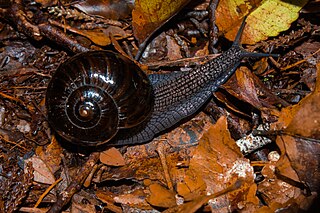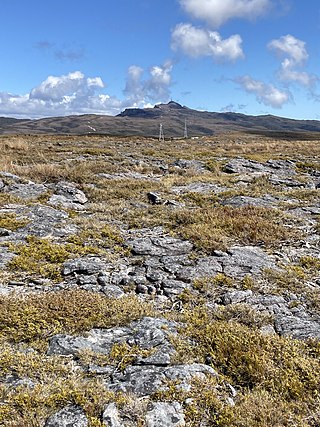Related Research Articles

Powelliphanta is a genus of large, air-breathing land snails, pulmonate gastropods in the family Rhytididae, found only in New Zealand. They are carnivorous, eating invertebrates, mostly native earthworms. Often restricted to very small areas of moist forest, they are prey to introduced mammalian predators, and many species are threatened or endangered.

The Save Happy Valley Coalition (SHVC) is an environmental activist movement formed with the express purpose of preventing the Cypress mine, an open cast coal mine on the West Coast of New Zealand, from proceeding.

Mount Burnett is a hill in Kahurangi National Park, in Golden Bay / Mohua, New Zealand.

Rhytididae is a taxonomic family of medium-sized predatory air-breathing land snails, carnivorous terrestrial pulmonate gastropod molluscs in the superfamily Rhytidoidea.

Powelliphanta superba is a species of large, carnivorous land snail in the family Rhytididae, which is endemic to the South Island of New Zealand. Five subspecies are recognised, all of which are classified by the New Zealand Department of Conservation as being Nationally Endangered.

Powelliphanta marchanti is a species of land snail in the family Rhytididae. It is endemic to New Zealand.

Powelliphanta augusta or the Mount Augustus snail, previously provisionally known as Powelliphanta "Augustus", is a species of large, carnivorous land snail, a terrestrial pulmonate gastropod mollusc in the family Rhytididae. Naturally occurring only on Mount Augustus near Westport on New Zealand's South Island, their entire habitat was destroyed by coal mining. The world population was taken into captivity, in theory until their habitat was restored and they could be released. The mining company concerned went bankrupt and habitat restoration has been unsuccessful, so the species' future is uncertain.

Powelliphanta patrickensis is a species of large, carnivorous land snail, a terrestrial pulmonate gastropod mollusc in the family Rhytididae. This species is endemic to the South Island of New Zealand. Formerly, it was considered as a subspecies of Powelliphanta rossiana.

Powelliphanta gilliesi, one of the "amber snails", is a species of large, carnivorous land snail, a terrestrial pulmonate gastropod mollusc in the family Rhytididae.

Powelliphanta traversi, known as Travers' land snail, is a species of large, carnivorous land snail, a terrestrial pulmonate gastropod mollusc in the family Rhytididae. This species is endemic to the North Island of New Zealand between Wellington and Lake Waikaremoana.

Powelliphanta lignaria, known as one of the amber snails, is a species of large, carnivorous land snail, a terrestrial pulmonate gastropod mollusc in the family Rhytididae. The eggs of P. lignaria are oval and seldom constant in dimensions 10 × 8.25, 9 × 7.75, 9 × 8, 8.75 × 7.75 mm.
This is an as-yet-unnamed Powelliphanta species, provisionally known as Powelliphanta "Egmont". It is one of the amber snails, an undescribed species of large, carnivorous land snail, a terrestrial pulmonate gastropod mollusc in the family Rhytididae.
An as-yet-unnamed Powelliphanta species is provisionally known as Powelliphanta sp. from the Baton River. This is one of the amber snails. It is an undescribed species of large, carnivorous land snail, a terrestrial pulmonate gastropod mollusc in the family Rhytididae.
This is a yet-unnamed Powelliphanta species, provisionally known as Powelliphanta "Nelson Lakes". This is one of the amber snails. It is an undescribed species of large, carnivorous land snail, a terrestrial pulmonate gastropod mollusc in the family Rhytididae. The area above the bush line on Mount Murchison in the Braeburn Range is one of three isolated habitats for this species.
The yet-unnamed Powelliphanta species of amber snails is provisionally known as Powelliphanta "Urewera". It is an undescribed species of large, carnivorous land snail, a terrestrial pulmonate gastropod mollusc in the family Rhytididae.
Powelliphanta "Lodestone" is a provisional name for an as yet undescribed species of large, carnivorous land snail, an "amber snail", a terrestrial pulmonate gastropod mollusc in the family Rhytididae.
This is a yet-unnamed Powelliphanta species, provisionally known as Powelliphanta sp. from Mount Owen. This is one of the amber snails. It is an undescribed species of large, carnivorous land snail, a terrestrial pulmonate gastropod mollusc in the family Rhytididae.

The Hunter Mountains of Fiordland, New Zealand, were named by surveyor James McKerrow after the famous anatomist John Hunter. The Hunter Mountain Range covers an area between The South Arm and Hope Arm of Lake Manapouri south to the Green Lake.

The Braeburn Range is a mountain range in the Tasman Region of New Zealand's South Island. It lies to the west of Lake Rotoroa and much of the eastern flank of the range is within the Nelson Lakes National Park. The range runs south-southeast, with a westwards curve at the northern end and several westward-trending spurs.

Denniston Plateau is an 18 km long, 600–800 m high coalfield plateau in the Papahaua Range on the West Coast of the South Island of New Zealand. A combination of impermeable rock, high rainfall, and shallow acidic soil has created a unique ecosystem of stunted trees and heath-like vegetation which is home to numerous endemic and undescribed species of plants and invertebrates. The plateau contains rich seams of high-quality coal, which led to the creation and abandonment of the mining towns of Denniston and Millerton, and the current Stockton Mine. Plans to create a new open-cast mine on the southern part of the plateau have become an environmental controversy.
References
- ↑ Trewick, Steven; Walker, Kath J.; Jordan, Corina J. (20 January 2008). "Taxonomic and conservation status of a newly discovered giant landsnail from Mount Augustus, New Zealand". Conservation Genetics. 9 (6): 1563. doi:10.1007/s10592-007-9495-8.